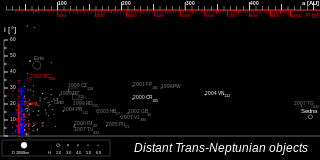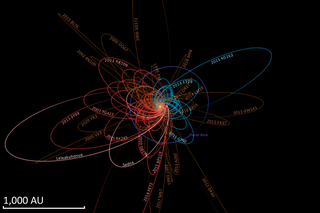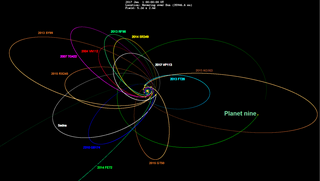Related Research Articles
A trans-Neptunian object (TNO), also written transneptunian object, is any minor planet in the Solar System that orbits the Sun at a greater average distance than Neptune, which has an orbital semi-major axis of 30.1 astronomical units (au).

(612911) 2004 XR190, nicknamed Buffy, is a trans-Neptunian object, classified as both a scattered disc object and a detached object, located in the outermost region of the Solar System. It was first observed on 11 December 2004, by astronomers with the Canada–France Ecliptic Plane Survey at the Mauna Kea Observatories, Hawaii, United States. It is the largest known highly inclined (> 45°) object. With a perihelion of 51 AU, it belongs to a small and poorly understood group of very distant objects with moderate eccentricities.
474640 Alicanto (provisional designation 2004 VN112) is a detached extreme trans-Neptunian object. It was discovered on 6 November 2004, by American astronomer Andrew C. Becker at Cerro Tololo Inter-American Observatory in Chile. It never gets closer than 47 AU from the Sun (near the outer edge of the main Kuiper belt) and averages more than 300 AU from the Sun. Its large eccentricity strongly suggests that it was gravitationally scattered onto its current orbit. Because it is, like all detached objects, outside the current gravitational influence of Neptune, how it came to have this orbit cannot yet be explained. It was named after Alicanto, a nocturnal bird in Chilean mythology.

Detached objects are a dynamical class of minor planets in the outer reaches of the Solar System and belong to the broader family of trans-Neptunian objects (TNOs). These objects have orbits whose points of closest approach to the Sun (perihelion) are sufficiently distant from the gravitational influence of Neptune that they are only moderately affected by Neptune and the other known planets: This makes them appear to be "detached" from the rest of the Solar System, except for their attraction to the Sun.

(612584) 2003 QX113 is a large trans-Neptunian object from the scattered disc located in the outermost region of the Solar System. It is one of the most distant objects from the Sun at 60.5 AU. It was discovered by astronomers with the Canada–France Ecliptic Plane Survey at Mauna Kea Observatories, Hawaii, when it was near aphelion on 31 August 2003. It was provisionally designated 2003 QX113.
(445473) 2010 VZ98 (provisional designation 2010 VZ98) is a trans-Neptunian object of the scattered disc, orbiting the Sun in the outermost region of the Solar System. It has a diameter of approximately 400 kilometers.

An extreme trans-Neptunian object (ETNO) is a trans-Neptunian object orbiting the Sun well beyond Neptune (30 AU) in the outermost region of the Solar System. An ETNO has a large semi-major axis of at least 150–250 AU. The orbits of ETNOs are much less affected by the known giant planets than all other known trans-Neptunian objects. They may, however, be influenced by gravitational interactions with a hypothetical Planet Nine, shepherding these objects into similar types of orbits. The known ETNOs exhibit a highly statistically significant asymmetry between the distributions of object pairs with small ascending and descending nodal distances that might be indicative of a response to external perturbations.

2015 RX245 is an extreme trans-Neptunian object, detached, on a highly eccentric orbit in the outermost region of the Solar System. It measures approximately 250 kilometers (160 miles) in diameter and is "possibly" a dwarf planet. It was first observed on 8 September 2015, by astronomers with Outer Solar System Origins Survey using the 3.6-meter Canada–France–Hawaii Telescope at Mauna Kea Observatories, Hawaii, in the United States.
2013 UH15 is an extreme trans-Neptunian object from the extended scattered disc in the outermost region of the Solar System, approximately 130 kilometers (81 miles) in diameter. It was first observed on 29 October 2013, by astronomers at the Las Campanas Observatory in the southern Atacama Desert of Chile. The detached extended scattered disc object (ESDO) is on a highly eccentric orbit and belongs to the extreme trans-Neptunian objects.
(533560) 2014 JM80 (provisional designation 2014 JM80) is a trans-Neptunian object (TNO) from the scattered disc in the outermost Solar System, approximately 340 kilometers (210 miles) in diameter. It was discovered on 9 May 2010 by astronomers with the Pan-STARRS-1 survey at the Haleakala Observatory, Hawaii, in the United States. According to American astronomer Michael Brown, it is "possibly" a dwarf planet.

2015 BP519, nicknamed Caju, is an extreme trans-Neptunian object from the scattered disc on a highly eccentric and inclined orbit in the outermost region of the Solar System. It was first observed on 17 January 2015, by astronomers with the Dark Energy Survey at Cerro Tololo Observatory (W84) in Chile. It has been described as an extended scattered disc object (ESDO), and fits into the group of extreme objects that led to the prediction of Planet Nine, and has the highest orbital inclination of any of these objects.
2014 FZ71 is a trans-Neptunian object, a scattered disc classified as a scattered and detached object, located in the outermost region of the Solar System. It was first observed on 24 March 2014, by a team led by American astronomer Scott Sheppard at the Cerro Tololo Inter-American Observatory in Chile. With its perihelion of almost 56 AU, it belongs to a small and poorly understood group of very distant objects with moderate eccentricities. The object is not a dwarf planet candidate as it only measures approximately 150 kilometers (93 miles) in diameter.
2014 FC72 is a trans-Neptunian object, classified as a scattered and detached object, located in the outermost region of the Solar System. It was first observed on 24 March 2014 by astronomers with the Pan-STARRS survey at Haleakala Observatory, Hawaii, United States. With its perihelion distant from Neptune, it belongs to a small and poorly understood group of objects with moderate eccentricities. It is estimated to measure 500 kilometers (300 miles) in diameter, assuming a low albedo.
2015 FJ345 is a trans-Neptunian object and detached object, located in the scattered disc, the outermost region of the Solar System. It was first observed on 17 March 2015, by a team led by American astronomer Scott Sheppard at the Mauna Kea Observatories, in Hawaii, United States. With its perihelion of almost 51 AU, it belongs to a small and poorly understood group of very distant objects with moderate eccentricities. The object is not a dwarf planet candidate as it only measures approximately 120 kilometers (75 miles) in diameter.
2015 KQ174 is a trans-Neptunian object, both considered a scattered and detached object, located in the outermost region of the Solar System. The object with a moderately inclined and eccentric orbit measures approximately 154 kilometers (96 miles) in diameter. It was first observed on 24 May 2015, by astronomers at the Mauna Kea Observatories in Hawaii, United States.
(523635) 2010 DN93 (provisional designation 2010 DN93) is a trans-Neptunian object from in the scattered disc located in the outermost region of the Solar System. It was discovered on 26 February 2010, by astronomers with the Pan-STARRS survey at Haleakala Observatory on the island of Maui, Hawaii, in the United States. Assuming a low albedo, the object is estimated at approximately 490 kilometers (300 miles) in diameter. It was numbered in 2018 and remains unnamed.

2013 FQ28 is a trans-Neptunian object, both considered a scattered and detached object, located in the outermost region of the Solar System. It was first observed on 17 March 2013, by a team of astronomers at the Cerro Tololo Inter-American Observatory in Chile. It orbits the Sun in a moderate inclined, moderate-eccentricity orbit. The weak dwarf planet candidate measures approximately 260 kilometers (160 miles) in diameter.
2013 SK100 is a trans-Neptunian object, both considered a scattered and detached object, located in the outermost region of the Solar System. The object with a moderately inclined and eccentric orbit measures approximately 135 kilometers (84 miles) in diameter. It was first observed on 29 September 2013, by astronomers at the Mauna Kea Observatories in Hawaii, United States.
2014 ST373 (prov. designation:2014 ST373) is a trans-Neptunian object and a detached object from the outermost region of the Solar System. With a perihelion of 50.2 AU, it belongs to the top 10 minor planets with the highest known perihelia of the Solar System. and is neither a scattered disc nor an extreme trans-Neptunian object. It measures approximately 370 kilometers (230 miles) in diameter and was first observed on 25 September 2014, by astronomers using the Dark Energy Camera (DECam) at Cerro Tololo Inter-American Observatory in Chile.
References
- 1 2 3 "2003 SS422". Minor Planet Center. Retrieved 5 March 2021.
- 1 2 3 "JPL Small-Body Database Browser: (2003 SS422)" (2020-11-18 last obs.). Jet Propulsion Laboratory . Retrieved 5 March 2021.
- 1 2 3 4 Johnston, Wm. Robert (18 August 2020). "List of Known Trans-Neptunian Objects". Johnston's Archive. Retrieved 5 March 2021.
- 1 2 3 "MPEC 2021-M14 : 2003 SS422". Minor Planet Center. 16 June 2021. Retrieved 16 June 2021.
- ↑ "Query (search criteria): objects perihelion min. 38 AU and semimajor axis min. 150 AU (found: 25 objects)". Minor Planet Center. Retrieved 5 March 2021.
- ↑ Volk, Kathryn; Malhotra, Renu (2024). "Machine Learning Assisted Dynamical Classification of Trans-Neptunian Objects". arXiv. doi:10.48550/arXiv.2405.05185 . Retrieved 13 May 2024.